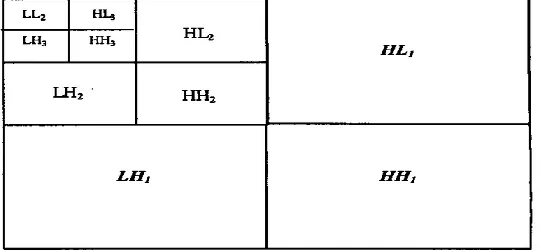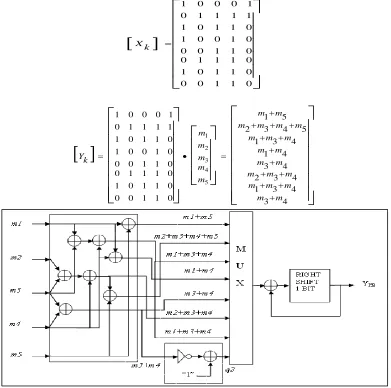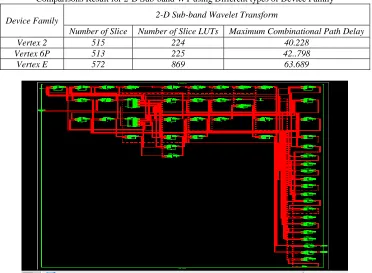VLSI Architecture for 2-D Sub-band Wavelet
Transform using 9/7 Wavelet Coefficient
Akanksha Yadav Anushree
PG Student Assistant Professor
Department ofElectronics & Communication (VLSI Design)
Hindustan college of science & Technology Farah, Mathura (India)
Department ofElectronics & Communication Hindustan college of science & Technology Farah, Mathura
(India)
Abstract
Two dimensional (2-D) discrete wavelet transform (DWT) is widely used in image and video compression. DWT is computational intensive so it demands real time processing. Several architectures have been suggested for efficient VLSI implementation of 2-D DWT for real-time applications. We found that multipliers consume more chip are and increases complexity of the DWT architecture. Multiplier-less hardware implementation approach provides a kind of solution to this problem due to its scope for lower hardware-complexity and higher throughput of computation. Several designs have been proposed for the multiplier-less implementation of DWT based on the principle of distributed arithmetic (DA). We found that DA requires ROM and size of ROM increases exponentially as the increase in no. of inputs, which highly increases the complexity. We have proposed a multiplier-less 2-D DWT architecture using new efficient distributed arithmetic algorithm (NEDA). NEDA is efficient algorithm, which does not require ROM. NEDA consist of adders as main component and free from multiplications and subtraction. We have proposed two architectures using NEDA and using modified NEDA. The proposed architecture using NEDA provides less delay and minimum number of slice compared the existing architecture. The proposed architecture is suitable for high speed on-line applications. It has 100% hardware utilization efficiency.
Keywords: Resister Transistor Logic (RTL), 9/7 Filter Coefficient, Sub-band Wavelet Transform ,NEDA, Xilinx Simulation
________________________________________________________________________________________________________
I.
I
NTRODUCTIONFourier Transform (FT) with its fast algorithms (FFT) is an important tool for analysis and processing of many natural signal s. FT has certain limitations to characterize many natural signals, which are non-stationary (e.g. speech). Though a time varying, overlapping window based FT namely STFT (Short Time FT) is well known for speech processing applications, a new time-scale based Wavelet Transform (WT) is a powerful mathematical tool for non-stationary signals.
Due to remarkable advantage of discrete wavelet transform (DWT) over the unitary transforms like discrete wavelet transform (DWT), discrete cosine transform (DCT), discrete sine transform (DST) and discrete Fourier transform (DFT), DWT is widely used in multimedia applications for efficient utilization of bandwidth with enhanced performance [1]. The amount of multimedia data processed is really huge and many of its applications required real-time processing for performance for better performance. To meet the timing requirement, DWT is implemented in a VLSI system [1, 2].
Due to remarkable advantage of discrete wavelet transform (DWT) over the unitary transforms like discrete wavelet transform (DWT), discrete cosine transform (DCT), discrete sine transform (DST) and discrete Fourier transform (DFT), DWT is widely used in multimedia applications for efficient utilization of bandwidth with enhanced performance [1,2]. The amount of multimedia data processed is really huge and many of its applications required real-time processing for performance for better performance. To meet the timing requirement, DWT is implemented in a VLSI system [3, 4].
Discrete Wavelet Transform (DWT) has been successfully used in the wide range of application including numerical analysis, signal analysis, image & video coding, pattern recognition, statistics and physics. DWT is two channels FIR filter computation composed of a Low-pass and a High-pass FIR filter. Low-pass sub band is further decomposed to achieve multilevel DWT computation but in certain application like medical, images, fingerprint where both the low and high pass sub band is required. For multilevel computation these is an achieved by using discrete wavelet packet transform (DWPT).
commonly used for implementation of convolution operations. In order to further reduce the area and power consumption but slow the speed in the architecture of DWPT [6].
In accordance with the multiple-level decomposition of a signal, the computation of the DWT can be performed by repeating a process in which a fully scalable window is shifted along the dimensions of the signal with the window size becoming shorter in each repetition. Many applications of the DWT computation involve large-volume data such as image or video.
II.
M
ULTILEVEL DISCRETE WAVELET TRANSFORMMultiresolution analysis (MRA) is a characteristic feature of SB and it is used for better spectral representation of the signal. In MRA, the signal is decomposed for more than one DWT level known as multilevel DWT. It means the low-pass output of first DWT level is further decomposed in a similar manner in order to get the second level of DWT decomposition and the process is repeated for higher DWT levels. Few algorithms have been suggested for computation of multilevel DWT. One of the most important algorithm are pyramid algorithm (PA), this algorithm are proposed Mallet (1989a) for parallel computation of multilevel DWT. PA for 1-D DWT is given by
)
2
(
)
(
)
(
11
0
i
n
Y
i
h
n
Y
ljk i j
l
(1))
2
(
)
(
)
(
11
0
i
n
Y
i
g
n
Y
hjk i j
h
(2)Where
Y
lj(
n
)
is the n-th low-pass sub band component of the j-th DWT level andY
hj(
n
)
is the n-th high-pass sub band component of the j-th DWT level. Two-dimensional signal, such as images, are analyzed using the 2-D DWT. Currently 2-D DWT is applied in many image processing applications such as image compression and reconstruction [Lewis and Knowles (1992)], pattern recognition [Kronland et al. (1987)], biomedicine [Senhadji et al. (1994)] and computer graphics [Meyer (1993)]. The 2-D DWT is a mathematical technique that decomposes an input image in the multiresolution frequency space. The 2-D DWT decomposes an input image into four sub bands known as low-low (LL), low-high (LH), high-low (HL) and high-high (HH) sub band.Fig. 1: Three Level Diagram of 2-Dsub-Band Wavelet Transform
III.
P
ROPOSED ARCHITECTUREThe block diagram of 9/7 wavelet coefficient based multilevel discrete wavelet transform using NEDA structure shown in figure 2. In this figure, input sample passing through 8-bit register after that all symmetrical delay input is add in the equation 3 to equation 7.
r(1)X(n)X(n6) r(2)X(n1)X(n5)
r(3) X(n2)X(n4
)
r(4)X(n3)We have used NEDA in 9/7 filter to remove multipliers. We have to apply NEDA two times get the 1-D 9/7 filter high pass
Where
h
0,h
1,h
2,h
3,h
4are the Low pass filter coefficients andg
0,g
1,g
2,g
3are the High pass filter coefficients.If we take the high pass coefficients
g
0,g
1,g
2andg
3 applied NEDA technique byr
1,r
2,r
3andr
4then we get the high passoutput
Y
Hof the 9/7 filter and we take the low pass coefficienth
0,h
1,h
2,h
3, andh
4applied NEDA technique bym
1,m
2,m
3,
m
4andm
5 then we get the low pass outputY
Lof the 9/7 filter. Example the low pass output step by step as shown in below:
5 4 3 2 1
4 3 2 1 0
m m m m m
h h h h h L Y
Let
m
1
1
,m
2
2
,m
3
3
,m
4
4
andm
5
5
. Then multiplier row and column and find out the low pass output 122.Where
h
0,h
1,h
2,h
3, andh
4daubechies 9/7 filter coefficients are 0.6029490, 0.2668444, -0.782232, -0.0168641 and0.02674875 respectively. All the daubechies 9/7 filter coefficients multiplied by 128 and get the 77, 34, -10, -2 and 3 respectively.
1225 4 3 2 1
3 2 10 34
77
H Y
We take the low pass coefficients
h
0,h
1,h
2,h
3, andh
4applied NEDA technique bym
1,m
2,m
3,m
4andm
5 then we getthe low pass output
Y
Lof the 9/7 filter.
5 4 3 2 1
00000011 11111110
11110110 00100010
1001101 0
m m m m m
L Y
0 0 0 1 1 1 1 1 1 0 0 1 0 1 0 0 1 1 0 0 0 1 0 0 1 0 1 1 0 1 1 1 1 1 0 1 0 0 0 1 k X
4 3 4 3 1 4 3 2 4 3 4 1 4 3 1 5 4 3 2 5 1 0 0 0 1 1 1 1 1 1 0 0 1 0 1 0 0 1 1 0 0 0 1 0 0 1 0 1 1 0 1 1 1 1 1 0 1 0 0 0 1 5 4 3 2 1 m m m m m m m m m m m m m m m m m m m m m m m m m m k YFig. 2: Proposed Architecture 1-D for Low Pass Filter Using NEDA Technique
In Figure 3.9, apply NEDA techniques step-1 all the input converts’ binary number
001
1
m
,m
2
010
,m
3
011
,m
4
100
,m
5
101
Step-2 all the binary input applied to sign extension so,
0001
)
1
(
s
,s
(
2
)
0010
,s
(
3
)
0011
,s
(
4
)
0100
,s
(
5
)
0101
Step-3 all the sign extension input applied to adder array so,
0110
)
1
(
m
,
m
(
2
)
1110
,
m
(
3
)
1000
,
0101
)
4
(
m
,m
(
5
)
0111
,1001
)
6
(
m
,m
(
7
)
1000
1001
1
)
(
)
8
(
not
m
3
m
4
m
Step-4 the entire adder array input applied to MUX so, The entire adder array input
m
(
1
)
right shift 1-bit so MUX (1) = 0’0110 =Yp (0) MUX (1) add MUX (2) = YP (1)= 0’0110 = 1110 + 100010
Output of the YP (1) again right shift 1-bit and adds MUX (3) so = 0’100010
YP (7) = 00001111010 = 122 Carry is rejected.
For 2-D sub-band WT, the outputs of 1-D high pass and low pass filters
Y
H1andY
L1are passed through series of shift registers and then we take the samples parallel using parallel data access method. The parallel data access method is used to minimize the memory requirement in 2-D sub-band WT.IV.
S
IMULATION RESULTAll the designing and experiment regarding algorithm that we have mentioned in this paper is being developed on Xilinx 6.2i updated version. Xilinx 6.2i has couple of the striking features such as low memory requirement, fast debugging, and low cost. The latest release of ISETM (Integrated Software Environment) design tool provides the low memory requirement approximate 27 percentage low. ISE 6.2i that provides advanced tools like smart compile technology with better usage of their computing hardware provides faster timing closure and higher quality of results for a better time to designing solution. By the aid of that software we debug the program easily. Also included is the newest release of the chip scope Pro Serial IO Tool kit, providing simplified debugging of high-speed serial IO designs for Virtex-2 FX and Virtex-E LXT and SXT FPGAs. With the help of this tool we can develop in the area of communication as well as in the area of signal processing and VLSI low power designing. We functionally 2-D sub-band WT verified presented in this paper including all low pass filter and high pass filter. We have been found from the results shown in table 1, that number of slices, number of slices LUTs and maximum combinational path delay used in different types of device family. RTL (resister transistor logic) view is 2-D sub-band tree structure in shown in figure 3.
Table - 1
Comparisons Result for 2-D Sub-band WT using Different types of Device Family
Device Family 2-D Sub-band Wavelet Transform
Number of Slice Number of Slice LUTs Maximum Combinational Path Delay
Vertex 2 515 224 40.228
Vertex 6P 513 225 42..798
Vertex E 572 869 63.689
Fig. 3: RTL View of 2-D Sub-Band Wavelet Transform
V.
C
ONCLUSIONR
EFERENCES[1] S.G. Mallat, “A Theory for Multiresolution Signal Decomposition: The Wavelet Representation”, IEEE Trans. on Pattern Analysis on Machine Intelligence, 110. July1989, pp. 674-693.
[2] M. Alam, C. A. Rahman, and G. Jullian, ”Efficient distributed arithmetic based DWT architectures for multimedia applications,” in Proc. IEEE Workshop on SoC for real-time applications, pp. 333 336, 2003.
[3] X. Cao, Q. Xie, C. Peng, Q. Wang and D. Yu, ”An efficient VLSI implementation of distributed architecture for DWT,” in Proc. IEEE Workshop on Multimedia and Signal Process., pp. 364-367, 2006.
[4] Archana Chidanandan and Magdy Bayoumi, “AREA-EFFICIENT NEDA ARCHITECTURE FOR THE 1-D DCT/IDCT,” ICASSP 2006.
[5] M. Martina, and G. Masera, ”Low-complexity, efficient 9/7 wavelet filters VLSI implementation,” IEEE Trans. on Circuits and Syst. II, Express Brief vol. 53, no. 11, pp. 1289-1293, Nov. 2006.
[6] M. Martina, and G. Masera, ”Multiplierless, folded 9/7-5/3 wavelet VLSI architecture,” IEEE Trans. on Circuits and syst. II, Express Brief vol. 54, no. 9, pp. 770-774, Sep. 2007.
[7] Gaurav Tewari, Santu Sardar, K. A. Babu, ” High-Speed & Memory Efficient 2-D DWT on Xilinx Spartan3A DSP using scalable Polyphase Structure with DA for JPEG2000 Standard,” 978-1-4244-8679-3/11/$26.00 ©2011 IEEE.
[8] B. K. Mohanty and P. K. Meher, “Memory Efficient Modular VLSI Architecture for Highthroughput and Low-Latency Implementation of Multilevel Lifting 2-D DWT”, IEEE TRANSACTIONS ON SIGNAL PROCESSING, VOL. 59, NO. 5, MAY 2011.
[9] B. K. Mohanty and P. K. Meher, “Memory-Efficient High-Speed Convolution-based Generic Structure for Multilevel 2-D DWT”, IEEE TRANSACTIONS ON CIRCUITS SYSTEMS FOR VIDEO TECHNOLOGY.


